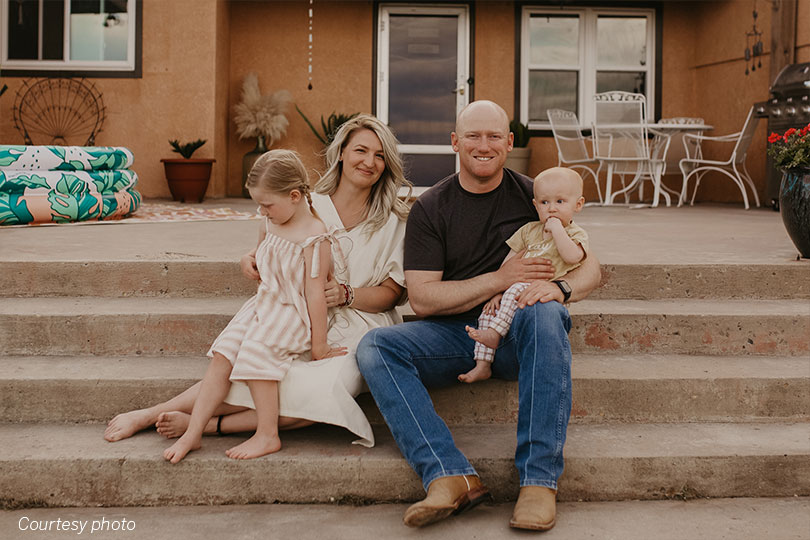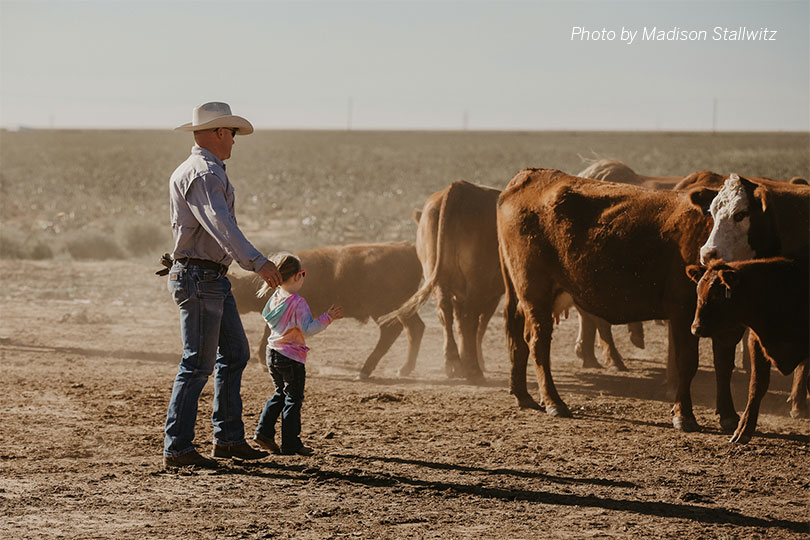By Julie Tomascik
Editor
In the Texas Panhandle, where the wind whips up the dust, Texas farm and ranch families stand strong and face whatever challenges fly their way.
One of the challenges facing Garrett and Madison Stallwitz is the increased market volatility brought on by the coronavirus (COVID-19) pandemic.
“We could use a rain, but that’s not unusual for this part of Texas. We could always use a rain,” Garrett said. “But we are a little uneasy about the market and what that means for some of our commodities.”
Garrett and Madison farm and ranch in Dumas with their two kids—Poppy and Hank.
The young couple is busy with planting season, feeding cattle and raising their kids. Garrett just finished planting corn and wheat harvest is a few weeks away.
They’re focusing right now on their cattle and the surprising opportunities they see from the COVID-19 pandemic.
“We’ve been talking seriously about feeding out calves and processing them locally and selling them,” Garrett said.
It’s something the young couple says they’ve always wanted to do.
“We’ve always wanted to do something like this. Now that COVID-19 has hit, it’s kind of pushed us to explore that direct-to-consumer market,” Madison said. “It’s almost the perfect opportunity for us as a team. I have a marketing degree, and I’m a professional photographer. I can do that side of it, and Garrett can bring the beef.”
But their local processors are booked through the end of the year.
“That might work out alright with the age of our cattle, but you’d like a little more certainty before moving forward,” he said.
It’s a risk and the increased cost of changing their business model that the couple has to consider.
The couple would like to purchase freezers to store the meat and purchase additional equipment to make feeding the calves easier.
“There’s always risk and an investment involved no matter what crop you grow or how you raise your livestock. We know that,” Garrett said.
And while they haven’t made definite plans on what their future holds for locally-processed beef, they are taking advantage of the time together as a family.
Poppy, their four-year-old daughter, enjoys the extra time spent with Garrett during the week.
“Poppy gets to spend even more time outside with Garrett,” Madison said. “She already went to work with Garrett some prior to COVID-19, but now she does it even more. She looks forward to it. She throws on her boots and jeans and tells us she’s ready to go work cattle with dad.”
The pandemic altered life somewhat for the Stallwitz family as it did for many in the Lone Star State. Social distancing and shelter-in-place orders also changed consumer purchasing habits, which Madison said has created an opportunity for agricultural awareness.
“This has helped bring to light the importance of agriculture and the role that farm and ranch families like ours play in bringing food to all of our tables,” Madison said. “I feel like agriculture is constantly changing. I didn’t grow up in this world, and I’m constantly learning something new every day. I think this gives us an opportunity to connect with those outside of farming and ranching.”
Agriculture and the food sectors were among the industries labeled critical and essential during the beginning of the pandemic.
“I think people haven’t always realized how fortunate we are in the U.S. to be able to keep food on the grocery store shelves,” Garrett said. “A lot of countries are used to not having items available all the time. Think this helps people understand a little bit about how important agriculture is to each of us.”
And while many are still sheltering in place, the Stallwitz family are still farming, still ranching and still raising their kids. Because what they do—raising livestock and growing crops—helps feed, fuel and clothe their friends, families and others around the country.
“We’re going to keep doing what we do every day, because that’s our job,” Garrett said.


